|
|
|
||
| HOME | NEWS | SPECIALS | |||
| September 16, 2002
NEWSLINKS |
|
The Rediff Special/Giridhar Gopal
 History records that Prince Siddhartha, who later became Gautam Buddha, was born in Lumbini village, near Kapilavastu town, in what is now southern Nepal. The UNESCO, the Government of India, and the world at large accept that Lumbini in Nepal was the birthplace of the Buddha.
History records that Prince Siddhartha, who later became Gautam Buddha, was born in Lumbini village, near Kapilavastu town, in what is now southern Nepal. The UNESCO, the Government of India, and the world at large accept that Lumbini in Nepal was the birthplace of the Buddha.
But now some archaeologists and historians based in Orissa have claimed that the Lumbini of history is not the village in Nepal, but one in present-day Orissa. The Utkal University Of Culture, based in Bhubaneswar, Orissa, has set up an eleven-member committee headed by Vice-Chancellor N K Mishra to study this claim. Orissa Museum Superintendent Dr Chandrabhanu Patel, who last month claimed that Gautam Buddha was born in a village on the outskirts of Bhubaneswar, is also on the committee. "I made the claim after a team of 15 archaeologists visited the site and found archaeological evidence corroborating our stand," he told rediff.com The place being touted by Patel is in Kapileswar village, on the outskirts of Bhubaneswar. Within Kapileswar is a small village, almost a part of the larger Kapileswar area now, known as Lembei. Patel says Kapileswar is the birthplace of the Buddha. He points out that a stone pillar with the inscriptions of Emperor Asoka, which was discovered in 1928 at Kapileswar and is at present in the Ashutosh Museum, Kolkata, states that the emperor, in the 20th year of his coronation, had worshipped at Buddha's birthplace at Kapileswar. The Orissa Museum superintendent said his team of archaeologists recently excavated different Buddhist sites in the state and after carefully examining the discovered rocks and inscriptions, felt they had sufficient evidence to believe that the Buddha was born in the state. He said his team had found four old sculptures of Asoka in the Kapileswar temple grounds, representing the four stages of Siddhartha's transformation from a prince to a sage. He added that according to the Buddhist religious textbook Tripitaka, Siddhartha was the son of a small estate owner who, according to the Chinese pilgrim Hieun Tsang, visited the different parts of Orissa. Patel claimed that Bhubaneswar was earlier known as Buddheswar, after the Buddha, while the region adjacent to Orissa's capital is known as Goutam Nagar, after Siddhartha's stepmother Goutami, who was also his mother's sister. In Orissa, Goutami is known as Mousima, and a temple complex called Mousima is still in existence on the periphery of Goutam Nagar, said Patel. He further said that Buddhism entered Nepal only in the sixth century AD, which was unlikely if the Buddha had been born there. Interestingly, this is not the first time that Lumbini, in Nepal, has been challenged as the birthplace of Buddha. Earlier, some researchers had claimed that he was born at Piprahwa village in Uttar Pradesh, since excavations there had thrown up an epigraph that read 'Kapilavastu Mahasangha'. But there was no further research into the matter. The Orissa government is backing the research into the claim. "We are going to organize a national debate in New Delhi to throw more light on the discovery," Culture Minister Dr Damodar Rout said. But the claim has received mixed response elsewhere. "When the Indian government has officially recognised Lumbini in Nepal as the birthplace of Gautam Buddha, the question of Orissa does not arise," said Monoj Mohapatra, who specialises on Buddhist archaeology. Noted historian Professor M N Das recalled a similar case four decades ago. "Such a claim was made way back in the 1960s by historian Chakradhar Mohapatra, who submitted a paper on it to the Utkal University. Some eminent historians then believed that Mohapatra's points were worth considering, but due to the lack of archaeological evidence, the research was not taken up," he told rediff.com Das, whose doctoral thesis was on Emperor Asoka, submitted, "I have studied Buddhism and a majority of the literature openly points to Lumbini in Nepal as the Buddha's birthplace. Thus those who say Orissa is the birthplace need to provide stronger evidence." The eastern state has quite a few linkages to the Buddha. One such story states that after the Buddha's death about 2,300 years ago, his tooth was brought to Kalinga (the ancient name of Orissa) and presented to the then king, who built a huge stupa (shrine) at Dantapuri. Added Das, "Dantapuri later came to be known as Puri." In Orissa abound several excavated Buddhist sites, which have yielded stupas and viharas (monasteries). The Archaeological Survey of India has also claimed to have discovered a gilded stone casket during an excavation at a site in the state 17 years ago. The stone casket is believed to contain the ashes of the Buddha. Meanwhile, responding to the Oriya claim, Lumbini Development Trust executive board member Narendra Man Joshi was quoted in a Nepali newspaper as saying, "Let us not call it [the claim] malicious. An individual researcher can pursue his idea. But the whole world knows that Buddha was born in Nepal's Lumbini, which is listed as a UNESCO heritage site." Design: Rahil Shaikh
|
|
| Tell us what you think of this report | |
|
HOME |
NEWS |
CRICKET |
MONEY |
SPORTS |
MOVIES |
CHAT |
BROADBAND |
TRAVEL ASTROLOGY | NEWSLINKS | BOOK SHOP | MUSIC SHOP | GIFT SHOP | HOTEL BOOKINGS AIR/RAIL | WEDDING | ROMANCE | WEATHER | WOMEN | E-CARDS | SEARCH HOMEPAGES | FREE MESSENGER | FREE EMAIL | CONTESTS | FEEDBACK |
|